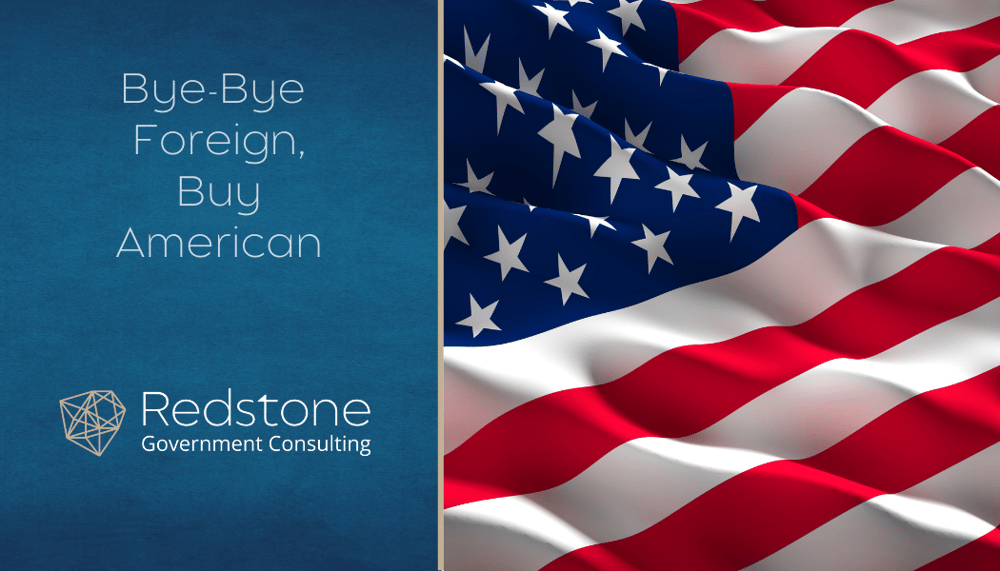
The FAR Council published a final rule on March 7, 2022, implementing revisions to the Buy American Act. The final rule strengthens the impact of Federal procurement preferences for products and construction materials domestically manufactured from substantially all domestic content and is effective October 25, 2022.
The final rule contains three major changes:- The domestic content requirement is increased over a span of seven years,
- There is a “fallback” threshold for products and construction materials to use the 55 percent domestic content threshold, and
- An enhanced price preference for domestic product/domestic construction material that is a critical item or consists of critical components.
Domestic Content Threshold Change
The current Buy American regulations require a product to contain 55 percent domestic content to qualify as domestic. The final rule increases the domestic content threshold from:
- 55 to 60 percent effective October 25, 2022,
- 65 percent in calendar year 2024, and
- 75 percent in calendar year 2029.
The initial increase from 55 to 60 percent is effective October 25, 2022, to allow contractors time to plan for the new threshold change. The threshold does not apply to commercially available off-the Shelf (COTS) items or to items made predominantly of iron and steel which have different rules. It is important to note that the domestic content threshold is applicable to items in the year of delivery not the year of contract award. For example, suppliers awarded contracts with a period of performance across several years of the domestic content thresholds are required to comply with each increased threshold for the items in the year of delivery.
FAR 25.101(d) and 25.201(c) were added to the FAR to provide that a senior procurement executive of the contracting agency in consultation with the Made in America Office can apply an alternate domestic content, in effect at the time of award, to the entire period of performance of the contract. This authority cannot be delegated. Since senior procurement executives are involved in the process, we do not believe this will be an option for most contractors – contracting officers are not fond of going to their boss’s boss’s boss.
Fallback Threshold
The final rule increases the domestic content threshold from 55 percent to 75 percent over a seven-year period. So what options are available to companies? The final rule provides for a Fallback Threshold that allows agencies to revert to the current threshold of 55 percent. It only applies to end products or construction materials that do not consist wholly or predominantly of iron or steel or a combination of both and are not commercially available off-the-shelf items.
For example, a company manufactures a Printed Circuit Board (PCB) that contains 57 percent domestic components and meets the 55 percent threshold in the current regulation. Effective October 25, 2022, when the new threshold of 60 percent is applicable, the PCB does not meet the increased domestic content threshold of 60 percent. Agencies can approve the use of the existing 55 percent domestic content threshold provided:
- there are no other products that meet the new threshold, or
- the price of products that meet the new threshold are unreasonable using the enhanced price preference.
The Fallback Threshold is available to agencies through 2030. It is intended to prevent taking work away from domestic suppliers as they work on adjusting their supply chains and reduce the use of issuing waivers. We anticipate numerous requests to Contracting Officers to approve the Fallback Threshold.
Enhanced Price Preference for Critical Products and Critical Components
The final rule addresses enhanced price preferences for critical items or products made up of critical components. FAR 25.003 had been modified to add definitions of “Critical component” and “Critical item” which are domestic products that are deemed critical to the U.S. supply chain. However, the list of critical items and the additional preference factor was not included in the final rule. Since there were a lot of concerns and feedback from the public on the critical items in the proposed rule, the Council decided to issue a separate FAR proposed rule to incorporate some of the feedback and allow for public comments on the list of critical items and the preference factors.
Currently, FAR 25.105 Determining Reasonableness of Cost, contains the price preference factor to be applied when a domestic offer is not the low offer, 20 percent if the lowest domestic offer is from a large business, or 30 percent if the lowest domestic offer is from a small business concern.
FAR 25.106(c) was added to address the enhanced preference factor for critical items and components. The change adds the additional preference factor for critical items (in FAR 25.105) to the 20 percent and 30 percent factors in the current regulation.
“(c) For end products that are critical items or contain critical components (1)(i) If there is a domestic offer that is not the low offer, and the restrictions of the Buy American statute apply to the low offer, the contracting officer shall determine the reasonableness of the cost of the domestic offer by adding to the price of the low offer, inclusive of duty— (A) 20 percent, plus the additional preference factor identified for the critical item or end product containing critical components listed at section 25.105, if the lowest domestic offer is from a large business concern; or (B) 30 percent, plus the additional preference factor identified for the critical item or end product containing critical components listed at section 25.105.”
What are the Next Steps?
Contractors should review their supply chain process and determine if products purchased will be impacted by the change in domestic threshold content and whether the parts qualify for the fallback threshold and a request to the Contracting Officer needs to be made. Be on the lookout for the proposed FAR rule addressing the list of critical items and additional preferences. We suggest you review the proposed FAR rule and provide comments. If, and when, the FAR is updated for the critical items and additional preferences, there will be different preferences for the critical items. Contractors will not only have to apply the preferences to non-critical items, but they will also have to become familiar with different percentages for critical items when determining the reasonableness of cost between a domestic and foreign item.
Redstone GCI is happy to assist contractors in evaluating their purchasing process to ensure compliance with the changed Buy America regulation and identify areas for improvement and change. Additionally, we are available to assist in reviewing purchasing policies and practices to ensure compliance with DFARS requirements, perform “mock audits” to assess whether purchasing files comply with policies, procedures, and regulation, and provide CPSR related training to contractor purchasing/buying departments.


 Lynne is a Director with Redstone Government Consulting, Inc. providing government contract consulting services to our clients primarily related to Commercial Item Determinations and support, Cost Accounting Standards, DFARS Business System Audits, Proposals, and Incurred Cost. Prior to joining Redstone Government Consulting, Lynne served in several capacities with DCAA and DCMA for over 35 years. Professional Experience Lynne began her career working with DCAA in the Honeywell Resident Office, Clearwater, FL in 1984. Lynne’s experience included various positions which involved conducting or reviewing forward proposals or rate audits, financial capability audits, progress payments, accounting and estimating systems, cost accounting standards, claims and disclosure statement reviews. She is an expert in FAR, DFARS, CAS and testified as an expert witness. Lynne assisted in drafting the commercial item guidance for DCAA Headquarters. Lynne was assigned as a Regional Technical Specialist where she provided guidance to 20 field offices on highly complex or technical issues relative to forward pricing, financial capability or progress payment issues. As an Assistant for Quality, she was involved in reviewing and ensuring audit reports were in compliance with policy and GAGAS as well as made NASBA certified presentations to the staff including but not limited to billing reviews, CAS, unallowable cost and progress payments. To enhance her experience in government contracting, Lynne accepted a position with DCMA in 2015 as part of the newly organized DCMA Cadre of Experts in the Commercial Item Group. This included performing reviews of prime contractor’s assertions and/or commercial item determinations as well as performing price analyses. Lynne was a project lead and later became a lead analyst where she engaged with the buying commands on requests and reviewed price analysis reviews performed by a team of 5 analysts. She also assisted the DCMA CPSR team relative to commercial items and co-instructed the Commercial Item Training presented to DCMA. Education Lynne earned a Bachelor of Science Degree in Accounting from the University of Central Florida. Certifications State of Florida Certified Public Accountant State of Alabama Certified Public Accountant Defense Acquisition Workforce Improvement Act (DAWIA) Level III- Auditing DAWIA Level III – Contracting
Lynne is a Director with Redstone Government Consulting, Inc. providing government contract consulting services to our clients primarily related to Commercial Item Determinations and support, Cost Accounting Standards, DFARS Business System Audits, Proposals, and Incurred Cost. Prior to joining Redstone Government Consulting, Lynne served in several capacities with DCAA and DCMA for over 35 years. Professional Experience Lynne began her career working with DCAA in the Honeywell Resident Office, Clearwater, FL in 1984. Lynne’s experience included various positions which involved conducting or reviewing forward proposals or rate audits, financial capability audits, progress payments, accounting and estimating systems, cost accounting standards, claims and disclosure statement reviews. She is an expert in FAR, DFARS, CAS and testified as an expert witness. Lynne assisted in drafting the commercial item guidance for DCAA Headquarters. Lynne was assigned as a Regional Technical Specialist where she provided guidance to 20 field offices on highly complex or technical issues relative to forward pricing, financial capability or progress payment issues. As an Assistant for Quality, she was involved in reviewing and ensuring audit reports were in compliance with policy and GAGAS as well as made NASBA certified presentations to the staff including but not limited to billing reviews, CAS, unallowable cost and progress payments. To enhance her experience in government contracting, Lynne accepted a position with DCMA in 2015 as part of the newly organized DCMA Cadre of Experts in the Commercial Item Group. This included performing reviews of prime contractor’s assertions and/or commercial item determinations as well as performing price analyses. Lynne was a project lead and later became a lead analyst where she engaged with the buying commands on requests and reviewed price analysis reviews performed by a team of 5 analysts. She also assisted the DCMA CPSR team relative to commercial items and co-instructed the Commercial Item Training presented to DCMA. Education Lynne earned a Bachelor of Science Degree in Accounting from the University of Central Florida. Certifications State of Florida Certified Public Accountant State of Alabama Certified Public Accountant Defense Acquisition Workforce Improvement Act (DAWIA) Level III- Auditing DAWIA Level III – Contracting